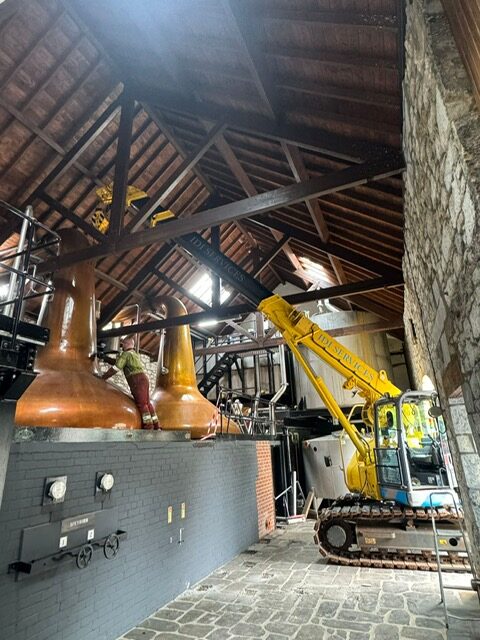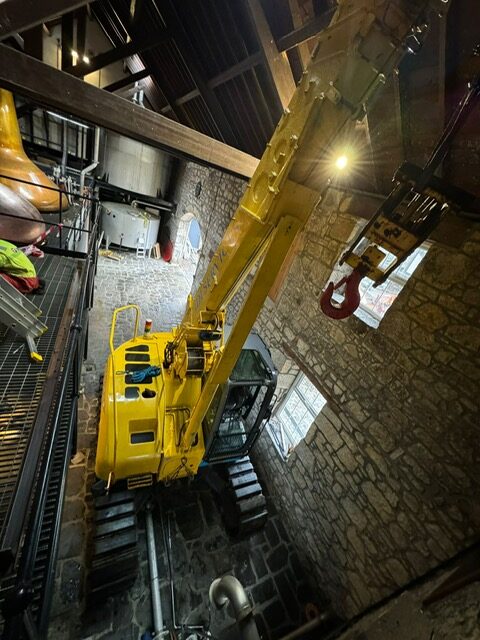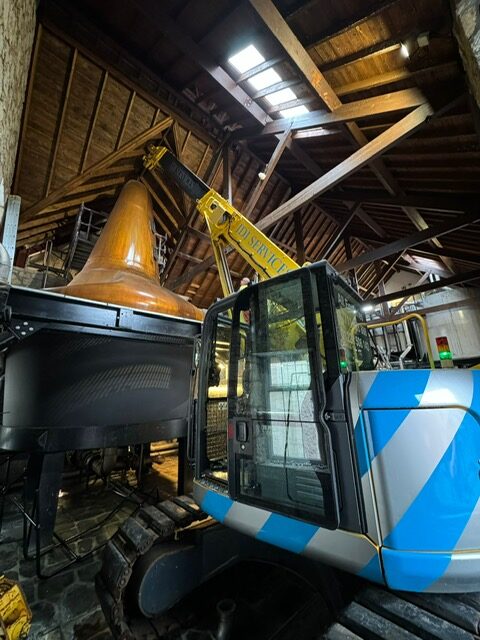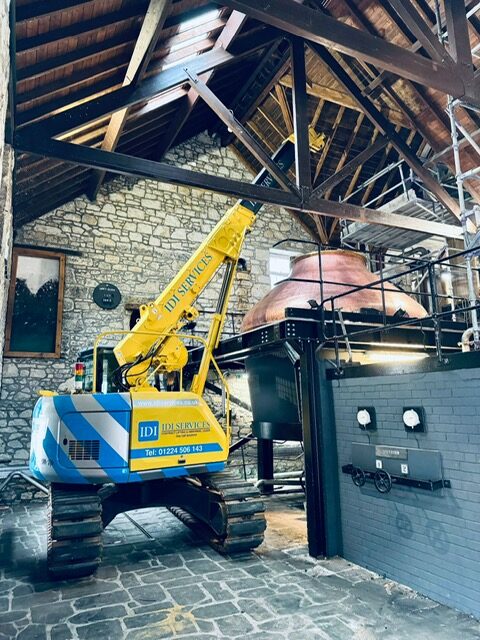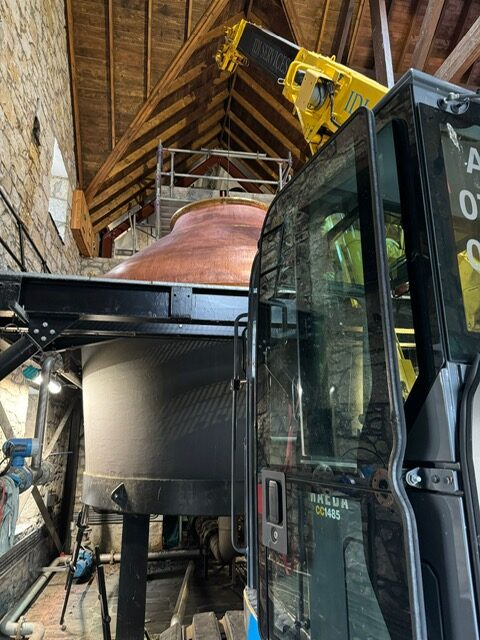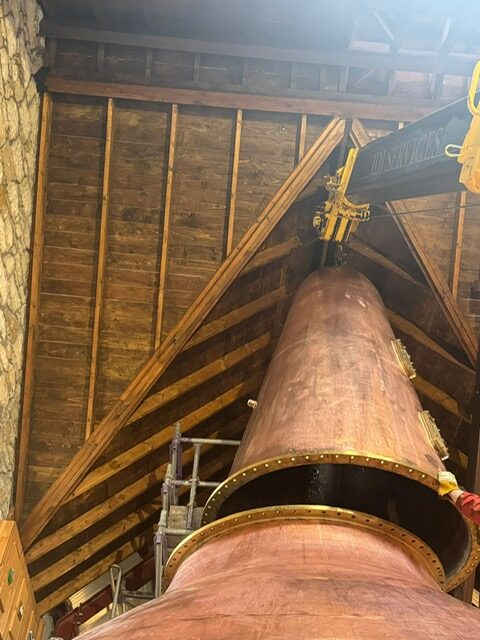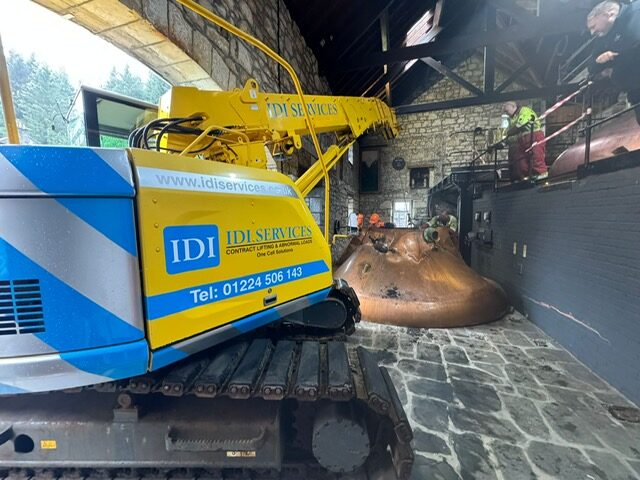
CASE STUDY: Historic Distillery Still Maintenance
IDI Services Delivers Compact Crane Expertise for Forsyths at Speyburn Distillery
Client Profile
Forsyths of Rothes, Scotland’s leading manufacturer of copper distillation equipment with over 175 years of heritage, required the replacement of critical still components at Speyburn Distillery, a historic Speyside facility renowned for its traditional whisky production. As the world’s premier stillmakers, Forsyths needed a lifting partner capable of working within the distillery’s historic stillhouse—a building where conventional lifting equipment simply cannot operate. The project demanded specialised compact crane capabilities to manoeuvre heavy copper components through severely restricted spaces whilst protecting the building’s traditional architecture and the irreplaceable copper stills themselves.
The Challenge
The Speyburn Distillery still parts replacement presented challenges that perfectly illustrate why conventional cranes fail in historic distillery environments:
Historic Building Constraints
- Speyburn Distillery’s traditional stillhouse features historic stone walls, wooden roof trusses, and architectural elements that cannot be modified or damaged.
- Original building design from the distillery’s establishment predates modern lifting equipment, creating access routes suited only to manual labour and small equipment.
- Low ceiling heights beneath historic wooden roof structures preventing conventional crane boom operation.
- Narrow doorways and access points designed for 19th-century distillery operations, not modern industrial equipment.
- Protected building status requiring absolute preservation of historic fabric and architectural features.
- Traditional cobblestone flooring requiring careful ground protection and load distribution.
Impossible Access for Conventional Equipment
- Conventional mobile cranes physically cannot access the stillhouse interior—doorways, ceiling heights, and building configurations make standard lifting equipment completely unsuitable.
- External crane access prevented by building design, with still locations deep within the historic structure.
- Multi-storey stillhouse configuration with elevated still heads requiring lifting operations at significant heights.
- Dense arrangement of copper stills, pipework, and traditional distillation infrastructure creating extremely confined working envelope.
- Historic roof trusses and structural timbers creating overhead obstacles throughout the working area.
Still Component Specifications
- Heavy copper still sections and components, including necks, lyne arms, and associated pipework weighing several hundred kilograms.
- Hand-beaten copper construction requiring meticulous handling to prevent damage to irreplaceable craftsmanship.
- Precise positioning requirements aligning replacement components with existing still bodies and connection points.
- Multiple components requiring sequential removal and installation operations.
- Substantial dimensions of copper sections creating manoeuvring challenges in confined spaces.
- High-value fabricated components representing significant investment by Forsyths and the distillery.
Operational Environment Factors
- Active distillery operations requiring coordination with production schedules and maintenance windows.
- Proximity to operating stills and hot surfaces during certain project phases.
- Coordination with Forsyths’ installation engineers ensuring copper components handled to their exacting standards.
- Protection of surrounding distillation equipment, instrumentation, and process systems.
- Heritage environment demanding respectful, careful operations preserving the distillery’s character.
The IDI Services Solution: Compact Crane Excellence
This project demonstrates exactly why IDI Services maintains two specialized compact cranes—equipment that provides access and capability where conventional lifting solutions are impossible:
Why Conventional Cranes Could Not Work
Access Impossibility:
- Standard mobile cranes cannot physically enter historic distillery buildings through traditional doorways.
- Building ceiling heights prevent conventional crane boom operation inside stillhouses.
- Historic architecture creates permanent barriers that cannot be modified to accommodate standard equipment.
- Still locations deep within multi-storey structures place them beyond external crane reach.
The Compact Crane Solution:
- IDI Services’ compact tracked crane navigated standard distillery doorways entering the historic stillhouse interior.
- Low overall height allowed operation beneath traditional wooden roof trusses and historic ceiling structures.
- Tracked undercarriage provided stability whilst distributing load across traditional flooring.
- Articulated boom configuration enabled precise positioning around copper stills and overhead obstacles.
- This project could not have been completed without specialized compact crane equipment.
Phase 1: Heritage Site Assessment and Detailed Planning
Our team conducted comprehensive planning recognizing the unique challenges of this historic environment:
- Detailed survey of Speyburn’s stillhouse documenting access routes, ceiling clearances, floor conditions, and architectural features requiring protection.
- Measurement of doorways, corridors, and internal spaces confirming compact crane access feasibility.
- Assessment of still component specifications provided by Forsyths, including weights, dimensions, lifting points, and handling requirements.
- Structural analysis of historic flooring ensuring load-bearing capacity for compact crane operations.
- Lift point identification and load path planning accounting for copper stills, overhead trusses, and confined working envelope.
- Development of comprehensive method statements and risk assessments specific to heritage building operations and irreplaceable distillation equipment.
- Coordination meetings with Forsyths’ technical team establishing installation sequences and quality control procedures.
- Ground protection planning preserving traditional cobblestone flooring throughout crane operations.
Phase 2: Compact Crane Deployment in Historic Environment
The specialized equipment enabled operations impossible with conventional cranes:
Historic Building Access:
- Compact crane navigated traditional distillery doorways that would prevent any conventional mobile crane entry.
- Careful movement through historic spaces with comprehensive protection of stone walls and architectural features.
- Tracked configuration allowing controlled passage across traditional cobblestone flooring with appropriate ground protection.
- Positioning within the stillhouse interior adjacent to copper stills requiring component replacement.
Working Environment Setup:
- Outrigger deployment in severely confined space utilizing compact footprint for operational stability.
- Assessment of overhead clearances beneath historic roof trusses ensuring safe boom operation.
- Lighting installation providing adequate visibility within the traditional stillhouse environment.
- Final safety briefings with Forsyths’ installation team and distillery personnel.
- Protection systems installed around copper stills and surrounding distillation equipment.
Phase 3: Still Component Removal Operations
The first phase involved careful removal of existing copper elements:
Preparation and Disconnection:
- Coordination with Forsyths’ engineers regarding still component disconnection procedures and sequences.
- Verification of copper section accessibility and lifting point preparation.
- Assessment of load trajectory paths navigating around adjacent stills, pipework, and overhead structures.
- Final pre-lift inspections of rigging equipment and lifting configurations.
Precision Removal:
- Controlled lifting of existing copper still components using specialized rigging designed for hand-beaten copper surfaces.
- Careful manoeuvring through confined stillhouse navigating around operating stills and traditional architecture.
- Articulated boom operation precisely positioning loads avoiding contact with historic roof trusses, stone walls, and adjacent equipment.
- Controlled lowering and removal of old components from the historic stillhouse maintaining protection throughout.
- Sequential removal operations as required by Forsyths’ installation phasing.
Phase 4: Replacement Component Installation
The critical installation phase demonstrated the compact crane’s precision capabilities in this challenging environment:
New Component Positioning:
- Rigging of replacement copper still sections using appropriate lifting equipment protecting hand-crafted surfaces.
- Controlled lift to elevated positions within the multi-storey stillhouse structure.
- Precise navigation through the confined space between multiple copper stills and overhead obstructions.
- Articulated boom operation allowing complex load trajectories impossible with conventional straight-boom cranes.
- Millimetre-accurate positioning aligning replacement components with existing still bodies and connection points.
Final Installation:
- Incremental adjustments under Forsyths’ engineers’ guidance achieving perfect alignment for copper still integrity.
- Temporary support of components whilst installation team completed connection procedures.
- Verification of positioning meeting Forsyths’ exacting standards for still geometry and distillation performance.
- Sequential installation of multiple components throughout the stillhouse as required.
- Continuous protection of surrounding stills and equipment throughout all operations.
Phase 5: Project Completion and Heritage Preservation
- Systematic demobilization of compact crane from historic stillhouse interior.
- Complete removal of ground protection systems and restoration of traditional cobblestone flooring.
- Final inspection confirming zero damage to historic building fabric, copper stills, or distillation equipment.
- Comprehensive documentation and handover to Forsyths and distillery management.
- Heritage site left in pristine condition preserving Speyburn’s traditional character.
The Results
The Forsyths project at Speyburn Distillery delivered exceptional outcomes whilst demonstrating the compact crane’s irreplaceable value:
Access Achievement—The Critical Success Factor
- Successful operation inside historic stillhouse where conventional cranes physically cannot access.
- Project completion enabled entirely by compact crane’s unique capabilities.
- Zero compromise to historic building integrity—no doorway modifications, structural alterations, or architectural damage required.
- Full lifting capability maintained within severely confined traditional distillery environment.
- Demonstration of equipment that solves problems conventional approaches cannot address.
Safety Performance
- Zero safety incidents throughout all operations within historic building and around irreplaceable copper stills.
- Full compliance with heritage building requirements, distillery safety protocols, and Forsyths’ quality standards.
- Complete protection of hand-beaten copper stills valued at hundreds of thousands of pounds.
- Preservation of historic architecture, traditional roof structures, and stone walls throughout operations.
Operational Excellence
- Precision positioning achieving exact alignment for copper still component connections and distillation integrity.
- Successful navigation of extremely confined space between multiple stills and under historic roof trusses.
- On-time completion meeting Forsyths’ installation schedule and distillery maintenance window.
- Zero damage to copper components, historic building fabric, or surrounding distillation equipment.
- Minimal disruption to distillery operations through efficient, professional execution.
Technical Achievement
- Complex load trajectories executed using articulated boom configuration in confined multi-storey environment.
- Millimetre-accurate positioning of heavy copper components at elevated heights.
- Successful coordination with Forsyths’ installation team maintaining their exacting craftsmanship standards.
- Heritage preservation achieving all project objectives whilst protecting irreplaceable historic fabric.
Partnership Success
- Seamless collaboration with Forsyths of Rothes reinforcing IDI Services’ position as their trusted lifting partner.
- Quality delivery meeting the exceptional standards expected when working with Scotland’s premier stillmakers.
- Repeat business foundation demonstrating reliability for future Forsyths projects across Scotland’s distilleries.
Client Testimonial
“IDI Services’ compact crane capabilities are essential for our still installation and maintenance work in Scotland’s historic distilleries. At Speyburn, conventional cranes simply could not access the stillhouse interior—it would have been physically impossible. Their specialized equipment allowed us to replace critical still components within the historic building whilst maintaining our standards for copper handling and installation quality. The team’s respect for both the irreplaceable stills and the heritage building environment exemplifies the professionalism we require in all our projects.”
— Technical Manager, Forsyths of Rothes
The Compact Crane Advantage: When Conventional Equipment Fails
This project perfectly illustrates the fundamental value proposition of IDI Services’ compact crane fleet:
The Access Problem in Historic Distilleries
Traditional Distillery Architecture: Scotland’s historic distilleries were built in the 19th and early 20th centuries when lifting operations meant manual labour and block-and-tackle systems. Buildings feature:
- Doorways sized for people and hand-carried components, not modern industrial equipment.
- Low ceiling heights beneath traditional roof structures.
- Dense arrangements of copper stills within confined stillhouses.
- Stone walls and architectural features that cannot be modified.
- Multi-storey configurations with stills positioned deep within building interiors.
Conventional Crane Limitations: Standard mobile cranes, even smaller models, cannot:
- Pass through traditional distillery doorways—physically too wide, too tall, or both.
- Operate beneath low ceilings in historic stillhouses.
- Reach still locations deep within multi-storey buildings.
- Navigate confined spaces between multiple stills and equipment.
- Function without building modifications that would damage heritage fabric.
The Compact Crane Solution: IDI Services’ two specialized compact cranes provide:
- Physical access through standard doorways and into historic building interiors.
- Low-height operation beneath traditional roof structures and ceiling constraints.
- Full lifting capability despite compact dimensions—suitable for heavy copper components.
- Articulated boom precision navigating around obstacles impossible for conventional equipment.
- Heritage-compatible operations requiring no building modifications or structural alterations.
Why IDI Services Maintains Two Compact Cranes
Strategic Equipment Investment: IDI Services operates two compact cranes specifically because they solve access problems that conventional equipment cannot address. This investment ensures:
- Availability for Scotland’s distillery sector and industrial facilities when these unique capabilities are needed.
- Backup capacity for critical projects where equipment failure would halt operations.
- Rapid deployment responding to Forsyths and other clients requiring specialized access solutions.
- Competitive advantage providing services unavailable from conventional crane operators.
Proven Essential for Distillery Sector: Working with Forsyths across Scotland’s distilleries has repeatedly demonstrated that compact cranes are not merely convenient—they are often the only viable solution:
- Historic stillhouses at facilities like Speyburn, Longmorn, and countless others cannot accommodate conventional equipment.
- Still installations, replacements, and maintenance operations depend on equipment that can access confined interiors.
- Partnership with Forsyths has established IDI Services as the lifting specialist for Scotland’s distilling heritage.
Where Compact Cranes Provide Unique Value
Historic Distillery Operations:
- Still installations, replacements, and component changes within traditional stillhouses.
- Equipment positioning in multi-storey distilleries with restricted access.
- Maintenance operations during production season requiring minimal disruption.
- Emergency repairs where rapid access to confined areas is critical.
Heritage Building Projects:
- Industrial facilities in historic structures throughout Scotland.
- Protected buildings where external crane access is prevented by architecture.
- Conservation projects requiring non-invasive lifting solutions.
- Listed buildings where structural modifications are prohibited.
Confined Industrial Environments:
- Food processing facilities with restricted internal access.
- Manufacturing plants with dense equipment layouts.
- Multi-storey industrial buildings built before modern lifting equipment existed.
- Any facility where doorways, ceilings, or space constraints prevent conventional crane access.
Distillery Sector Specialization
IDI Services’ relationship with Forsyths and extensive experience across Scotland’s distilling industry positions us as the sector’s specialist lifting partner:
Comprehensive Distillery Capabilities
- Still installations and replacements in historic stillhouses.
- Copper component handling requiring specialized rigging and protection.
- Condenser positioning and heat exchanger installations.
- Process equipment upgrades and facility expansions.
- Emergency response for equipment failures during production season.
Partnership with Forsyths
- Trusted lifting partner for Scotland’s premier stillmakers.
- Understanding of Forsyths’ quality standards and installation requirements.
- Proven capability across diverse distillery facilities throughout Scotland.
- Repeat business foundation built on reliable, professional delivery.
Heritage Environment Expertise
- Respect for traditional distillery architecture and protected buildings.
- Non-invasive operations preserving historic fabric and character.
- Comprehensive protection systems for irreplaceable copper stills.
- Understanding of distillery operations and production schedules.
Why Choose IDI Services for Historic Distillery Projects
When conventional lifting equipment cannot access your facility, IDI Services provides the specialized solution:
Unique Equipment Capabilities
- Two compact cranes ensuring availability for Scotland’s distillery and industrial sectors.
- Proven access through historic doorways and into confined building interiors.
- Full lifting capability despite compact configuration—suitable for heavy distillery components.
- Heritage-compatible operations requiring no building modifications.
Distillery Sector Expertise
- Partnership with Forsyths establishing credibility and proven capability.
- 45+ years of experience across Scotland’s distilling industry.
- Understanding of copper still handling, distillery operations, and heritage preservation.
- Trusted reputation among distillery operators, contractors, and equipment manufacturers.
Technical Excellence
- Precision execution achieving exact positioning for critical distillery equipment.
- Articulated boom capabilities navigating complex confined environments.
- Comprehensive planning addressing all aspects of heritage building operations.
- Quality assurance protecting irreplaceable equipment and historic architecture.
Safety and Reliability
- Zero-incident culture maintaining highest standards in challenging environments.
- Full regulatory compliance meeting heritage building and distillery sector requirements.
- Professional execution earning trust of clients like Forsyths who demand excellence.
- Proven track record delivering results where conventional approaches fail.
When Conventional Cranes Cannot Reach—Compact Cranes Deliver
Scotland’s historic distilleries present a fundamental challenge: modern lifting requirements within 19th-century buildings designed for manual labour. Traditional stillhouses at facilities like Speyburn feature doorways, ceilings, and spatial configurations that make conventional crane access physically impossible.
This is not a problem to be overcome through building modifications—protected heritage status, architectural value, and operational realities prevent structural alterations. Instead, it demands different equipment: compact cranes specifically designed to operate where conventional lifting equipment fails.
The Forsyths project at Speyburn Distillery demonstrates this reality perfectly. Conventional mobile cranes could not enter the historic stillhouse. External cranes could not reach still locations deep within the multi-storey structure. The project required equipment that could navigate traditional doorways, operate beneath historic roof trusses, and manoeuvre heavy copper components through confined spaces between operating stills—capabilities that only specialized compact cranes provide.
IDI Services maintains two of these specialized cranes precisely because Scotland’s distilling industry and industrial heritage depend on them. When Forsyths calls for still installations across Speyside, when historic facilities require equipment upgrades, when confined spaces demand lifting capability—our compact crane fleet provides solutions that conventional equipment simply cannot deliver.
Whether your project involves historic distillery operations, heritage building facilities, confined industrial environments, or any lifting challenge where access constraints defeat conventional approaches, IDI Services delivers the specialized equipment, technical expertise, and proven reliability that solves problems others cannot address.
For more information on how IDI Services’ compact crane capabilities can access your historic facility or confined space project, contact our team today.

